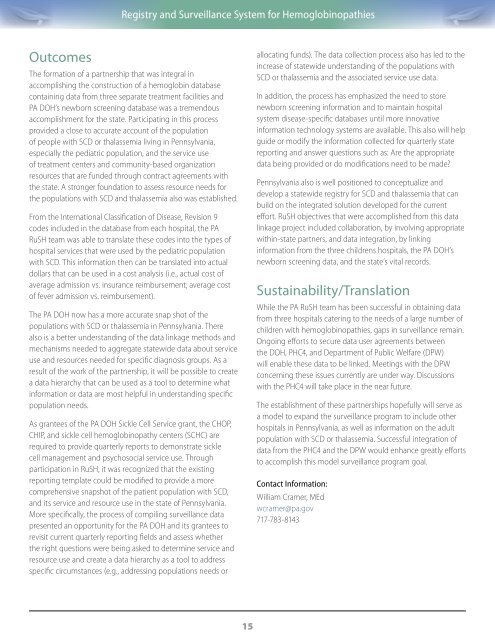RuSH: Strategies from the Field - Centers for Disease Control and ...
RuSH: Strategies from the Field - Centers for Disease Control and ...
RuSH: Strategies from the Field - Centers for Disease Control and ...
Create successful ePaper yourself
Turn your PDF publications into a flip-book with our unique Google optimized e-Paper software.
Outcomes<br />
Registry <strong>and</strong> Surveillance System <strong>for</strong> Hemoglobinopathies<br />
The <strong>for</strong>mation of a partnership that was integral in<br />
accomplishing <strong>the</strong> construction of a hemoglobin database<br />
containing data <strong>from</strong> three separate treatment facilities <strong>and</strong><br />
PA DOH’s newborn screening database was a tremendous<br />
accomplishment <strong>for</strong> <strong>the</strong> state. Participating in this process<br />
provided a close to accurate account of <strong>the</strong> population<br />
of people with SCD or thalassemia living in Pennsylvania,<br />
especially <strong>the</strong> pediatric population, <strong>and</strong> <strong>the</strong> service use<br />
of treatment centers <strong>and</strong> community-based organization<br />
resources that are funded through contract agreements with<br />
<strong>the</strong> state. A stronger foundation to assess resource needs <strong>for</strong><br />
<strong>the</strong> populations with SCD <strong>and</strong> thalassemia also was established.<br />
From <strong>the</strong> International Classification of <strong>Disease</strong>, Revision 9<br />
codes included in <strong>the</strong> database <strong>from</strong> each hospital, <strong>the</strong> PA<br />
<strong>RuSH</strong> team was able to translate <strong>the</strong>se codes into <strong>the</strong> types of<br />
hospital services that were used by <strong>the</strong> pediatric population<br />
with SCD. This in<strong>for</strong>mation <strong>the</strong>n can be translated into actual<br />
dollars that can be used in a cost analysis (i.e., actual cost of<br />
average admission vs. insurance reimbursement; average cost<br />
of fever admission vs. reimbursement).<br />
The PA DOH now has a more accurate snap shot of <strong>the</strong><br />
populations with SCD or thalassemia in Pennsylvania. There<br />
also is a better underst<strong>and</strong>ing of <strong>the</strong> data linkage methods <strong>and</strong><br />
mechanisms needed to aggregate statewide data about service<br />
use <strong>and</strong> resources needed <strong>for</strong> specific diagnosis groups. As a<br />
result of <strong>the</strong> work of <strong>the</strong> partnership, it will be possible to create<br />
a data hierarchy that can be used as a tool to determine what<br />
in<strong>for</strong>mation or data are most helpful in underst<strong>and</strong>ing specific<br />
population needs.<br />
As grantees of <strong>the</strong> PA DOH Sickle Cell Service grant, <strong>the</strong> CHOP,<br />
CHIP, <strong>and</strong> sickle cell hemoglobinopathy centers (SCHC) are<br />
required to provide quarterly reports to demonstrate sickle<br />
cell management <strong>and</strong> psychosocial service use. Through<br />
participation in <strong>RuSH</strong>, it was recognized that <strong>the</strong> existing<br />
reporting template could be modified to provide a more<br />
comprehensive snapshot of <strong>the</strong> patient population with SCD,<br />
<strong>and</strong> its service <strong>and</strong> resource use in <strong>the</strong> state of Pennsylvania.<br />
More specifically, <strong>the</strong> process of compiling surveillance data<br />
presented an opportunity <strong>for</strong> <strong>the</strong> PA DOH <strong>and</strong> its grantees to<br />
revisit current quarterly reporting fields <strong>and</strong> assess whe<strong>the</strong>r<br />
<strong>the</strong> right questions were being asked to determine service <strong>and</strong><br />
resource use <strong>and</strong> create a data hierarchy as a tool to address<br />
specific circumstances (e.g., addressing populations needs or<br />
15<br />
allocating funds). The data collection process also has led to <strong>the</strong><br />
increase of statewide underst<strong>and</strong>ing of <strong>the</strong> populations with<br />
SCD or thalassemia <strong>and</strong> <strong>the</strong> associated service use data.<br />
In addition, <strong>the</strong> process has emphasized <strong>the</strong> need to store<br />
newborn screening in<strong>for</strong>mation <strong>and</strong> to maintain hospital<br />
system disease-specific databases until more innovative<br />
in<strong>for</strong>mation technology systems are available. This also will help<br />
guide or modify <strong>the</strong> in<strong>for</strong>mation collected <strong>for</strong> quarterly state<br />
reporting <strong>and</strong> answer questions such as: Are <strong>the</strong> appropriate<br />
data being provided or do modifications need to be made?<br />
Pennsylvania also is well positioned to conceptualize <strong>and</strong><br />
develop a statewide registry <strong>for</strong> SCD <strong>and</strong> thalassemia that can<br />
build on <strong>the</strong> integrated solution developed <strong>for</strong> <strong>the</strong> current<br />
ef<strong>for</strong>t. <strong>RuSH</strong> objectives that were accomplished <strong>from</strong> this data<br />
linkage project included collaboration, by involving appropriate<br />
within-state partners, <strong>and</strong> data integration, by linking<br />
in<strong>for</strong>mation <strong>from</strong> <strong>the</strong> three childrens hospitals, <strong>the</strong> PA DOH’s<br />
newborn screening data, <strong>and</strong> <strong>the</strong> state’s vital records.<br />
Sustainability/Translation<br />
While <strong>the</strong> PA <strong>RuSH</strong> team has been successful in obtaining data<br />
<strong>from</strong> three hospitals catering to <strong>the</strong> needs of a large number of<br />
children with hemoglobinopathies, gaps in surveillance remain.<br />
Ongoing ef<strong>for</strong>ts to secure data user agreements between<br />
<strong>the</strong> DOH, PHC4, <strong>and</strong> Department of Public Welfare (DPW)<br />
will enable <strong>the</strong>se data to be linked. Meetings with <strong>the</strong> DPW<br />
concerning <strong>the</strong>se issues currently are under way. Discussions<br />
with <strong>the</strong> PHC4 will take place in <strong>the</strong> near future.<br />
The establishment of <strong>the</strong>se partnerships hopefully will serve as<br />
a model to exp<strong>and</strong> <strong>the</strong> surveillance program to include o<strong>the</strong>r<br />
hospitals in Pennsylvania, as well as in<strong>for</strong>mation on <strong>the</strong> adult<br />
population with SCD or thalassemia. Successful integration of<br />
data <strong>from</strong> <strong>the</strong> PHC4 <strong>and</strong> <strong>the</strong> DPW would enhance greatly ef<strong>for</strong>ts<br />
to accomplish this model surveillance program goal.<br />
Contact In<strong>for</strong>mation:<br />
William Cramer, MEd<br />
wcramer@pa.gov<br />
717-783-8143

















